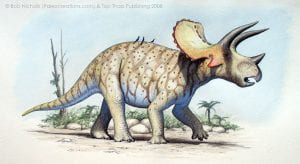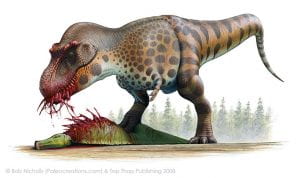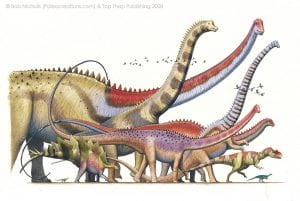This post was orginally written and posted in the blog, here, for Centre for Environmental Humanities, University of Bristol
Illustrations kindly supplied by Robert Nicholls and used with permission.
Since their discovery less than 200 years ago, dinosaurs have invaded popular culture, appearing in literature, fiction, art, film and entertainment. Dinosaur displays draw eager visitors to museums, and dinosaur-related feature films yield some of the highest box-office returns of all time.[1] A general public usually indifferent to science reacts enthusiastically to a new dinosaur discovery reported in popular news and media channels. Yet the word ‘dinosaur’ is still used to refer to something – or someone – out of date, extinct, obsolete and inflexible.
Apart from their entertainment value, why are dinosaurs relevant today? Why spend time, effort and money studying an apparently extinct group of animals? Because dinosaurs were the dominant life form on land for over 200 million years. They were amazingly diverse – they came in all shapes and sizes, from the size of a raven to the largest animals ever to walk on land, living all over the planet from the Antarctic to Siberia, from Scotland to China.
So, first, if we want to understand life in its entirety, we need to understand how and why dinosaurs became so successful, how they adapted to variations in their environment and how they dominated the planet for so long.
Second, and perhaps more urgent today, we need them to tell us what went wrong – what were the global repercussions of a massive asteroid impact? What exactly caused the extinction* of such resilient, adaptable creatures? Dinosaurs lived through some  of the most dramatic environmental upheavals the planet has experienced – variations in oxygen levels, climate, even the position of the land masses – yet, in the end, were at the mercy of their changing environment.
of the most dramatic environmental upheavals the planet has experienced – variations in oxygen levels, climate, even the position of the land masses – yet, in the end, were at the mercy of their changing environment.
Third, some dinosaurs were the largest creatures to walk the planet, massive creatures more than ten times the size of an elephant. Scientists in the field of biomechanics are trying to understand how they lived, exceeding any limits we can even imagine from extant life. How did they live? Eat? Mate? Grow? Understanding them helps us to understand how evolution solves the problems of life.
Understanding them helps us to understand how evolution solves the problems of life.
If the environmental humanities study our relationship with, and effect on, our environment, the dinosaurs can put that in context. More than that, the popularity of dinosaurs in contemporary culture needs the methodologies used by the humanities to understand the underlying critical influences in their interpretations. Any representation of a dinosaur is a product of speculation and that speculation can carry hidden bias and social influences even when based on known science.

*Except, of course, the dinosaurs didn’t die out. Today, around 10,000 species of them feed on your garden feeders, fly overhead and sing at dawn. Birds are dinosaurs, evolved from a common ancestor in the branch of theropods that included T. rex – and T. rex is more closely related to a hummingbird than to a stegosaurus.
[1] See, for example, the increase in numbers to Birmingham Museum and Art Gallery when they displayed the diplodocus skeleton from May to Sept 2018 https://advisor.museumsandheritage.com/news/dippy-dinosaur-sized-impact-tour-breaks-records-bmag/ [accessed 260419]. Among worldwide grossing films of all time, Jurassic World is no. 5 and Jurassic World: Fallen Kingdom no 12. Jurassic Park comes in at no. 32. https://www.boxofficemojo.com/alltime/world/ [accessed 260419].


